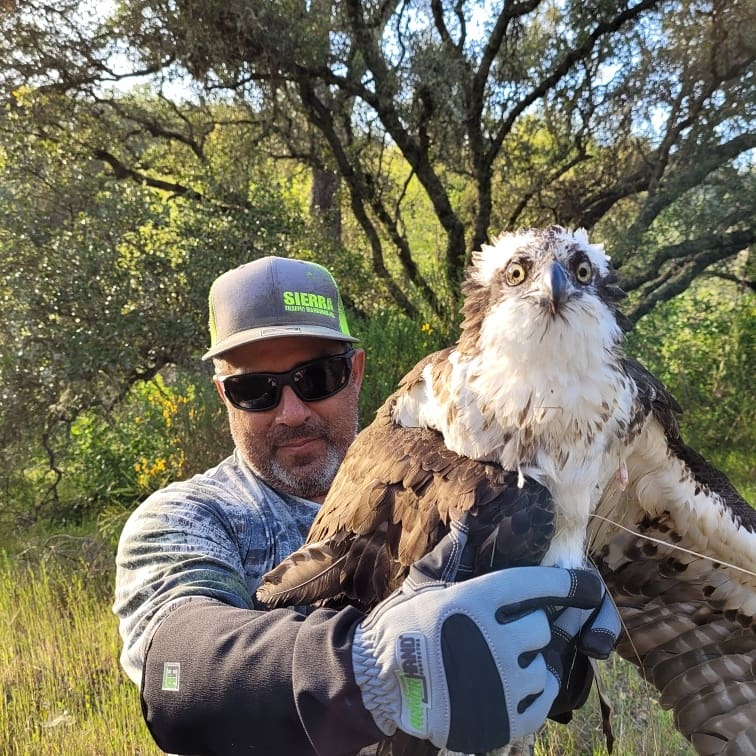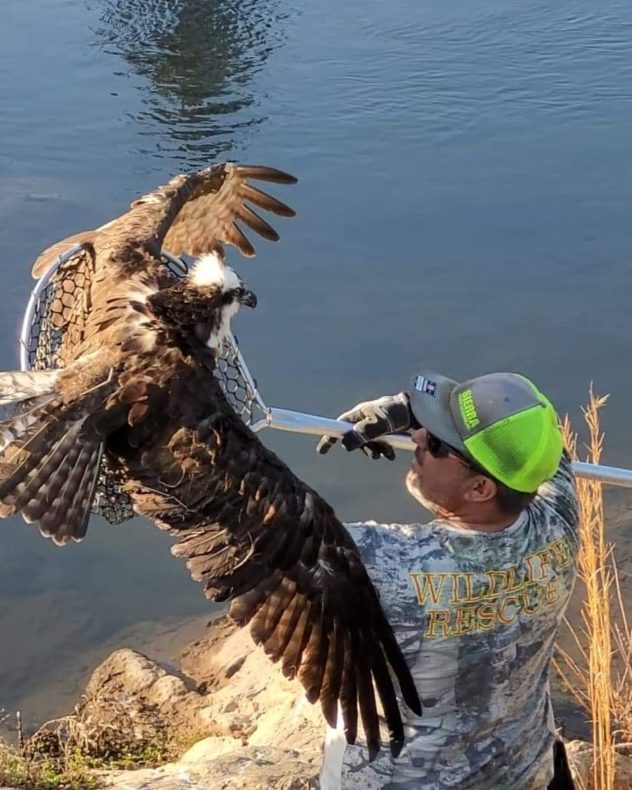
Pete has a poison oak rash in his armpit. The backs of my knees and left shoulder blade are starting to itch. It’s a sign of spring—a sign that last weekend, for the first time in a while, we did something really good.
No, not that. Last weekend we hopped fences, clambered over downed trees, scaled boulders, and hacked through thickets of poison oak in search of an incredible, majestic, injured bird.
LOOK AT THIS BIRD! Have you ever seen anything so dignified? Or so affronted? Here’s how we found ourselves unexpectedly searching a river canyon for an injured osprey: Last weekend, Pete, two friends, and I decided to float down a stretch of whitewater on the South Fork American River. A few miles downstream, we approached a house-sized boulder known to locals as Gorilla Rock because it looks exactly like a gorilla in profile. As we floated, Pete spotted something odd on the river bank: a two-foot-tall, brownish-black and white osprey sitting on a flat rock next to the water.
I don’t know a lot about birds, but I do know that godlike raptors don’t just sit on the ground like that. If they’re going to rest, they do it from a lofty vantage point, where they can assert their superiority. As Shakespeare puts it in Act 4 Scene 5 of Corionalus (thank you Wikipedia):
I think he’ll be to Rome
As is the osprey to the fish, who takes it
By sovereignty of nature.
It was obvious something was wrong, and became even more obvious when we tentatively approached. He or she (it’s really hard to tell an osprey’s sex without a blood test) flopped into the water, attempted the saddest failed bird-swim you can possibly imagine, then crawled back onto the rock. One wing looked injured; there was some blood. The osprey puffed its feathers up, we backed off.
I admit that for a very stupid, fleeting moment, I wondered if it might be possible to take off my three-quarter inch-thick wetsuit, swaddle the osprey in it, and… what? Navigate the next 10 miles of rapids with an injured, distressed raptor in my boat? A second look at the razor sharp talons and fish-spearing beak sobered me up. Instead, I yelled at a group of kayakers passing by: “Does anyone have the contact number for a wild bird rescue service on them?”
As it happened, someone did. His name, I think, was Doug. Doug knew by heart the phone number of a woman who specializes in raptor rescue. Byron, one of my boating companions, had a few fleeting bars of cell service. He texted the woman. We were in luck, she said: Although she lived an hour and a half away, she was heading our way to rescue an injured gosling.
Byron sent this miraculous person a GPS pin of the osprey’s exact location. Then, like the former Bureau of Land Management employee he is, he offered to stay and guard the osprey for a few hours, to keep anyone else from pestering it. The rest of us headed downstream.
That could have been the end of it—but whence the poison oak welts?
Once we were driving out of the river canyon, soggy, smelly, and back in cell service, we got a call from a team of wildlife rescue professionals that the woman had apparently asked to go find the osprey instead. They’d tried to find the pin. They were on the wrong side of the river.
We offered to guide them to our best estimate…. of where some roads might?… lead to where the bird had been? We (I) really did think we knew where we were going. After all, it was only ten or fifteen years, or maybe twenty now that I think of it dear God years ago that I’d driven down that dirt road to Gorilla Rock myself to hang out with an oh-so-long-ago boyfriend. Did teenagers still do that? Surely they did.
Several No Trespassing signs later, it was clear that the road I vaguely remembered no longer existed. The two professionals, dressed in official-looking camo T-shirts and toting a net, carrier, and thick gloves, were very quiet. I hoped stony silence was normal for people in their line of work. Pete and I led them further into the scrubby foothills, shouting things like, “We can hear the river!”
By the time we actually did reach the river, about five hours had passed since we’d first spotted the injured osprey. It was hard to believe the bird could still be there, but we all agreed there was no point in giving up now. We were about a half-mile further downstream from Gorilla Rock than we’d intended to be, so started bushwhacking upstream through blackberries, boulders, and thick, lush curtains of poison oak. Did I mention that I was wearing my apres-river outfit, a sundress, and Pete was wearing flip-flops?
Laura and Byron had gone to look for a better access point in their respective trucks. I asked Ben if this was a typical rescue for him. He said that eagles and hawks (which include osprey) are not known for getting stranded in convenient places.
Oh! The suspense as we climbed over those boulders, looking for the granite niche where the osprey had been. “That bird had better be there,” Pete muttered. “The bird has to be there,” I said.
There the osprey was, looking bedraggled. Ben donned his gloves, wielded his net in a swift downward movement, and soon held the enormous bird by its ankles. The osprey extended a nearly six-foot wingspan; I gasped to see up close something I’d only ever seen or expected to see as a distant silhouette. I was surprised that the osprey didn’t struggle; although it tried to peck at Ben’s face once or twice, it seemed too exhausted to resist.

Pete got to help untangle its closed talons from the net; I helped tuck its oily, water-resistant feathers into a mesh carrier. It bothers me that I’ll never know exactly how the osprey felt about being rescued. Like a downed pilot captured on enemy territory, perhaps? At this particular juncture in history, that wide-eyed stare and those demented feathery eyebrows feel a little too familiar: As certain People of LWON put it, “That bird is all of us,” and “It me.” After the team had taken the osprey to a wildlife rescue center, I texted Ben to see how it was doing. He didn’t know, but said he’d check. Apparently people don’t always get to keep tabs on the wildlife they help save once the professionals take over. Which, when I consider the lengths (scratch) we went to rescue the osprey (scratch, scratch), makes perfect sense.
What an amazing adventure! I’m sure you’ll be telling this story for years to come.
(And whoever said, “It me” … I agree 100%. It me also.)
David, “It me” seems to be a near-universal response to this bird at the moment. May our feathers all be smoothed soon.
Thanks for this story! I love the moment when you “helped tuck its oily, water-resistant feathers into a mesh carrier.” How often do we get to aid live, wild animals, and to know them in this small, seemingly intimate way?
I once spent a quiet hour standing at a distance from a seal that had stranded itself on a beach in New Jersey. Before me, there had been a couple, also standing about, looking at the seal’s all-to-knowing eyes, glancing at the small amount of blood near its flippers. I shooed away kids and curious dogs. The seal and I waited for animal control or the tide to run up the beach, whichever came first, as the sun started to go down. How many walks I had taken on that same beach, I do not know. But it is always the afternoon of the seal that I return to with the same feeling of surprise.
Rachel, thank you for reading it! I love your seal story.
Beautiful writing! I’m the wildlife woman that Doug contacted. May I post a link on my rescue FB page?
Oh my gosh! Stephanie! Hero! Yes, of course!
I helped a Canadian Goose get over a fence to its mate. It was injured and could not fly I suppose. For me it was an incredible feeling, like being “one” with Nature. Your Osprey adventure is incredible too! Well done!